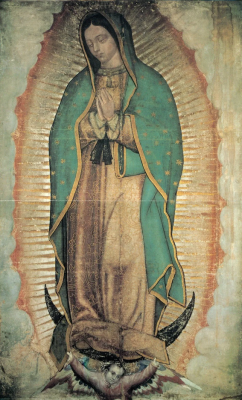Gospel in Art: Feast of Our Lady of Guadalupe

Our Lady of Guadalupe, Pigment on tima (cactus fibre wove cloak). Dated to the Marian apparitions in 1531 ©Wikimedia Commons
Source: Christian Art
Gospel of 12 December 2023
Matthew 18:12-14
Jesus said to his disciples: 'Tell me. Suppose a man has a hundred sheep and one of them strays; will he not leave the ninety-nine on the hillside and go in search of the stray? I tell you solemnly, if he finds it, it gives him more joy than do the ninety-nine that did not stray at all. Similarly, it is never the will of your Father in heaven that one of these little ones should be lost.'
Reflection on the Devotional Image
Today we celebrate the memorial of Our Lady of Guadalupe. Our Lady of Guadalupe is associated with a series of five Marian apparitions to a Mexican peasant named Juan Diego and his uncle, Juan Bernardino, which occurred in December 1531. At the same time an image of Our Lady miraculously appeared on St Juan Diego's tilma (poncho) in the same year. Pope Leo XIII (1810-1903) granted the image a decree of Canonical Coronation on 8 February 1887, and it was pontifically crowned on 12 October 1895. The basilica in Mexico City is one of the most-visited Catholic shrines in the world.
It was on 12 December 1531, during her last apparition, that Our Lady left her image on Juan Diego's tilma, which was made of cactus fibre. She bore in mind the local beliefs of the Aztec people. This led to a precious image of Our Lady that is full of symbols that were meant to teach the Aztec people about who she was and highlight her love for the local population. Firstly her skin complexion appears to be that of the local indigenous people. More specifically she is portrayed as mestizo (a combination of Mexican and Spanish), indicating that she is for all people. Her eyes are cast downwards, indicating to them that she was not a god and symbolising her humility.
Our Lady wears a rose-tinted tunic (rose being symbolic for a 'new dawn') with four-petaled flowers imprinted on it, symbolising the four seasons. Wrapped around her is a bluish-turquoise cloak with stars upon it. This is the colour of both royalty and the heavens. She may not be a god, but she is certainly in Heaven. The circle medallion around her neck encloses an image engraved with a cross. This symbolises her consecration to her son Jesus Christ. Behind her are rays of sunlight. This has been interpreted by some to convey that Mary is greater than the Aztec sun god. Similarly, she stands upon the moon, showing possibly her superiority to the Aztec moon god and that she is greater than the night. Of course the sun and moon stand for so much different artistic symbolic richness. Not one interpretation alone needs to be chosen.
And the history of this image continues nowadays. John Paul II included the liturgical celebration of Our Lady of Guadalupe in the General Roman Calendar as an optional memorial in 2002. Pope Francis granted the image a second Golden Rose via Cardinal Marc Ouellet for presentation at the Basilica in 2013.
LINKS
Gospel in Art: https://christian.art/
Today's Reflection: https://christian.art/daily-gospel-reading/matthew-18-12-14-2023/


















